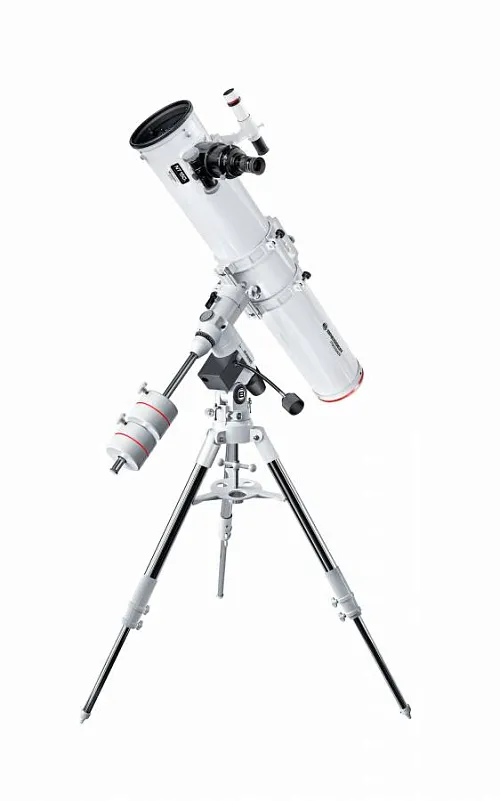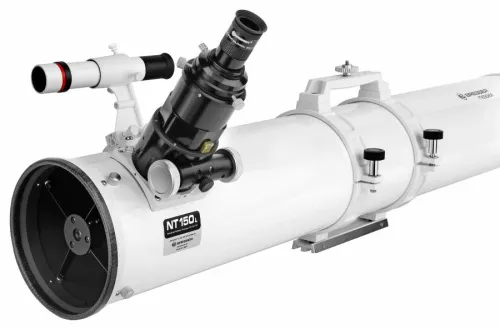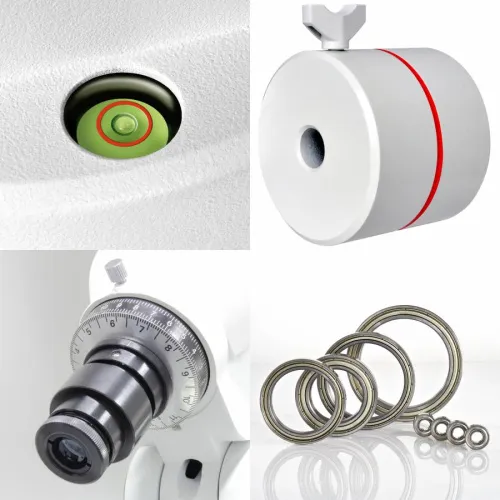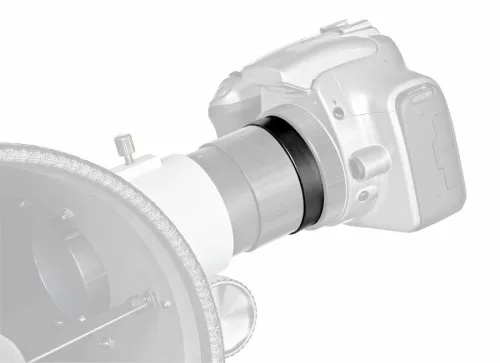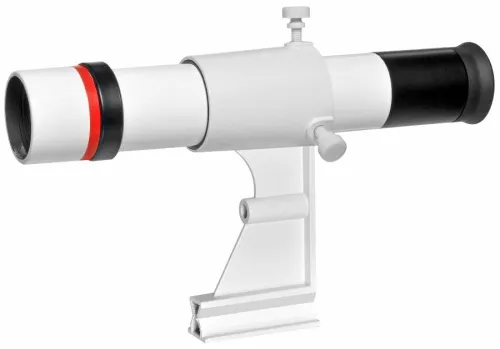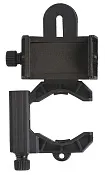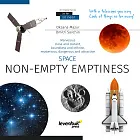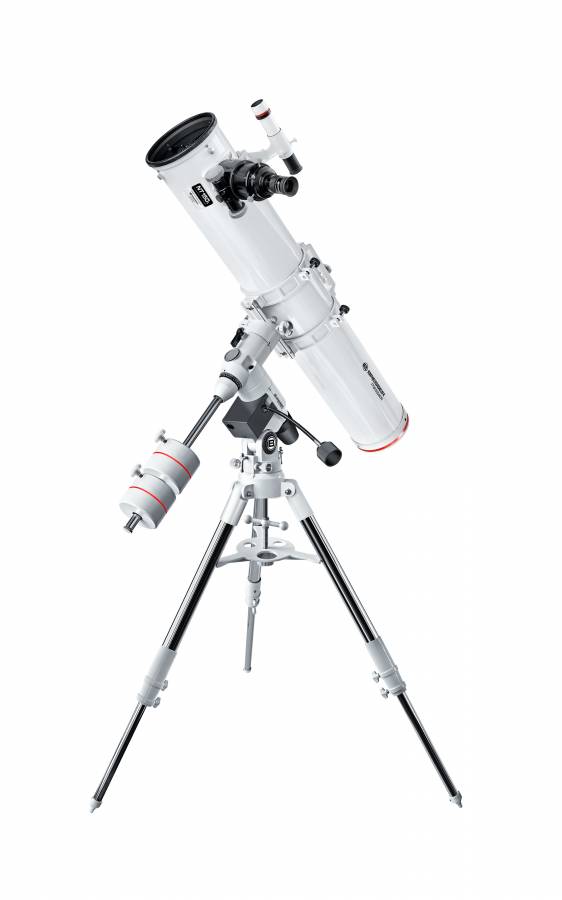Bresser Messier NT-150L/1200 Hexafoc EXOS-2/EQ5 Telescope
Newton's telescope. Primary mirror diameter (aperture): 150mm. Focal length: 1200mm
Reflector
Optical design
150
Aperture – the diameter of the light-collecting lens or mirror that the telescope uses to collect light
1200
Focal length – the distance from the primary lens or mirror to the point at which the light is focused
| Product ID | 72880 |
| Brand | Bresser GmbH, Germany |
| Warranty | 2 years |
| EAN | 4007922199351 |
| Package size (LxWxH) | 39x134x53 cm |
| Shipping Weight | 30.7 kg |
Description
This telescope features rigid and sharp optics. The 150 mm light gathering aperture allows for observing the bright celestial dee sky objects. This telescope allows for observing the colorful glowing Great Orion Nebula, detecting the famous Whirlpool Galaxy in the Big Dipper, and finding the Dumpbell-Nebula in the constellation Vulpecula. The rigid precision mount with ball bearings in all axes provides a stable stand and makes this telescope suitable for astrophotography.
Bresser Messier NT-150L/1200 Hexafoc EXOS-2/EQ5 Telescope features an equatorial mount.
Features:
- High end Hexafoc-focuser with 2.5" free inner diameter
- Ball beared axes (RA/DEC) and worm gears for smooth and precise tracking
- Adjustable polar finder scope
- Bubble level for easy tripod setup
- 6x30 straight through viewfinder with a reticle
- Optimized finder socket for comfortable use
- Cradle rings with a handle and integrated piggyback camera holder (1/4" thread)
- Dovetail plate with a stainless steel rail
- 50.8 mm (2") to 31.7 mm (1.25") adapter with integrated T2 thread (T2-adapter ring for your camera is required)
The kit includes:
- 26 mm Super Plössl eyepiece (31.7 mm/1.25")
- Built-in T2-adapter for a 31.7 mm (1.25") eyepiece
- Adapter for 50.8 mm (2") eyepieces
- Mount ring (for EXOS and LXD-75)
- Handle with camera holder
- 6x30 viewfinder
- Stellarium astronomy software
- User guide
- Rotatable star map
- EXOS-2 German equatorial mount with stainless steel tube field tripod
Specifications
| Product ID | 72880 |
| Brand | Bresser GmbH, Germany |
| Warranty | 2 years |
| EAN | 4007922199351 |
| Package size (LxWxH) | 39x134x53 cm |
| Shipping Weight | 30.7 kg |
| Optical design | reflector |
| Optical scheme | Newtonian |
| Primary mirror diameter (aperture), mm | 150 |
| Secondary mirror diameter, mm | 45 |
| Focal length, mm | 1200 |
| Magnification, x | 46 — 300 |
| Resolution threshold, arcseconds | 0.86 |
| Mount | equatorial, EXOS-2/EQ5 |
Reviews
Telescope accessory installation diagrams (.pdf) (13.12.2019)
Convenient diagrams that describe how to install additional accessories on refractors and catadioptric telescopes
Convenient diagrams that describe how to install additional accessories on refractors and catadioptric telescopes
Levenhuk Telescope Assembly Guide (14.12.2019)
Find out how to assemble a telescope on an example of the Levenhuk Skyline 90x900 EQ telescope
Find out how to assemble a telescope on an example of the Levenhuk Skyline 90x900 EQ telescope
A quick guide for novice astronomers (16.12.2019)
This short guide will help you avoid typical mistakes and learn more about telescope and mounting types
This short guide will help you avoid typical mistakes and learn more about telescope and mounting types
A telescope: how to start observing (16.12.2019)
The basics of astronomical observations for beginners
The basics of astronomical observations for beginners
Frequently Asked Questions – Telescopes (20.04.2020)
In this article we have gathered answers to some of the most frequently asked questions about telescopes
In this article we have gathered answers to some of the most frequently asked questions about telescopes
Telescope Under a Microscope: How Does It Work? (18.05.2020)
How telescopes work?
How telescopes work?
First Steps in Astronomy Made Easy! (18.05.2020)
You can actually perform observations from your balcony!
You can actually perform observations from your balcony!
Beginner’s Short Guide to Telescopes (18.05.2020)
All about telescope sizes, types, magnification, and mounts
All about telescope sizes, types, magnification, and mounts
How to use a telescope (18.05.2020)
Learn how to set up and use the telescope properly
Learn how to set up and use the telescope properly
Astronomical observations in the city (18.05.2020)
Astronomy in light-polluted skies. Find out what you can observe in the city
Astronomy in light-polluted skies. Find out what you can observe in the city
Telescopes for children (19.05.2020)
Read an interesting comprehensive article on telescopes for little astronomers
Read an interesting comprehensive article on telescopes for little astronomers
Things you can see with a telescope based on its aperture (19.05.2020)
Celestial objects you can observe with telescopes of different apertures
Celestial objects you can observe with telescopes of different apertures
What can you see with a telescope (19.05.2020)
Colored and vivid images of galaxies, planets and star clusters entrance everyone who is fascinated by boundless space
Colored and vivid images of galaxies, planets and star clusters entrance everyone who is fascinated by boundless space
What is a refracting telescope? (20.05.2020)
Find an interesting review on the history of the changes to a refracting telescope
Find an interesting review on the history of the changes to a refracting telescope
How to choose a telescope (20.05.2020)
To make the process of choosing a telescope easier, we will tell you about the characteristics of the most popular types of telescopes today
To make the process of choosing a telescope easier, we will tell you about the characteristics of the most popular types of telescopes today
A short guide to refractor telescopes: choose your equipment wisely (20.05.2020)
Learn everything you need to know about refractor telescopes to make the right choice
Learn everything you need to know about refractor telescopes to make the right choice
Questions and Answers
Submit your question/feedback

